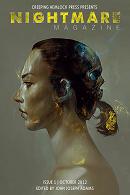“Property Condemned: A Story of Pine Deep” by Jonathan Maberry
Reviewed by Cyd Athens
As promised during his Kickstarter campaign, John Joseph Adams has delivered a healthy sibling to Lightspeed. The proud parents, Horror and Dark Fantasy, named the new arrival Nightmare. Four award-caliber authors, bearing the gift of never before published stories, were among the first to visit the newborn.
Jonathan Maberry proved an adept harbinger of doom with his tale, “Property Condemned: A Story of Pine Deep.” The story follows a boy, Crow, who has become accustomed to being beaten by his alcoholic father. They live in Pine Deep, a town that tourists visit in the hopes of sighting a ghost. One day, Crow and three friends decide to visit the town’s haunted house, a condemned property so foreboding that a coffin might be more alluring. Youthful egos get the better of common sense and after a few rounds of dares and bravado, the quartet enters. Their experiences could give a person nightmares if he or she could sleep afterward.
Just as the children are drawn into the house, Mr. Maberry draws readers into the story by daring us to keep reading. Vivid passages make it difficult for us to turn back lest we think ourselves sissies. Though haunted houses are a mainstay of the genre, this one warns us not to trifle with it. It is not a place with hackers, slashers, or zombies. This is much worse. If we enter, it will chew us up and spit us out. Haunted house story fans, don’t miss this one.
Laird Barron entertained Nightmare with “Frontier Death Song.” In this story, a former sled dog racer has the misfortune to witness the Wild Hunt. The good news is that his interruption saves his friend from a fate worse than death. The bad news is that the legends are true. The friend, Steven Graham, becomes the Huntsman and pursues him and his dog, Minerva, with murderous intent. Over the river and through the woods, with a stop for coffee and another for a few of hours sleep, it is not to Grandfather’s house that the hero goes. Rather, he takes his woes to a friend who is knowledgeable in the area of occultism. The Huntsman follows. The two groups meet. All hell breaks loose.
The story is told in first person point of view. Just about every character in it has a name—except the hero. This is but a minor distraction. Pacing for the story matches the urgency with which the hero tries to escape. The Huntsman tracks and taunts his victim with not only hell hounds but also sadistic glee and a macabre sense of humor. Mr. Barron has spun a tale designed to make us paranoid and petrified.
Genevieve Valentine’s contribution to the celebration, “Good Fences,” is about a man, Alan, who would never admit that he suffers from insomnia. During his wakeful periods in the middle of the night, he sometimes looks out the window at the goings-on in his rundown neighborhood. After he sees a parked car on fire, he decides not to get involved in what he increasingly believes is a crime committed by street punks. The burned out hulk becomes the elephant in the room. Neither Alan nor any of his neighbors discuss it. However, while Alan doesn’t want to stare, he can’t look away. When a neighbor disappears, Alan’s overactive imagination gets the best of him and he believes the worst—that the man was killed in the car fire. Eventually, Alan notices that there really are burnt remains in the car. He isn’t sure whether they belong to the missing neighbor or one of the hooligans. Then he has to decide what to do about it.
Though this story is the shortest of those here, it packs no less of a punch. Ms. Valentine’s offering is well and solidly crafted. Alan’s suspicious nature is contagious. Be advised: read with caution and closed blinds.
That Sarah Langan’s story, “Afterlife” is last, by no means makes it least. Her hero, forty-five year old Mary Hogan, lives with a controlling, hoarder mother, Corinne. Corinne’s husband lives across the street with a floozy. And Mary? Well, she lives upstairs in the attic with the ghosts of dead children. Being a kind person, Mary takes an interest in these kids. Being homeschooled and not well educated, she has little to offer them but compassion. The dysfunctional relationship between Mary and Corinne does not encourage open and honest communication, so Mary keeps her ghost friends a secret. Corinne has her own secrets. One of them is that she hasn’t paid the rent or utilities in so long that she and Mary are going to be evicted. Then Mary finds out about another of her mother’s secrets. And the marshals come to remove mother and daughter from the residence.
Ms. Langan has done her homework and it shows. These are strong characters who could be real people. Their character traits, flaws, and psychologies are dead-on. Desperation and hopelessness seep through. Whether or not it is possible to defeat the monsters here only becomes clear at the end of the story.
As a bonus, Nightmare presents RJ Sevin’s opinion piece, “The H Word: The Other Scarlet Letter.” It is a provocative look at how movies and zombies and comics (oh, my) have helped to stigmatize the horror genre.
The first part of an interview with legend Peter Straub, as well as spotlights on not only cover artist Jeff Simpson, but also all four authors herein, provide finishing touches. If this issue is an indication of what Nightmare’s future holds, we look forward to reading more.
Cyd Athens indulges a speculative fiction addiction from 45ø 29 30.65 N, 122ø 35 30.91 W.
